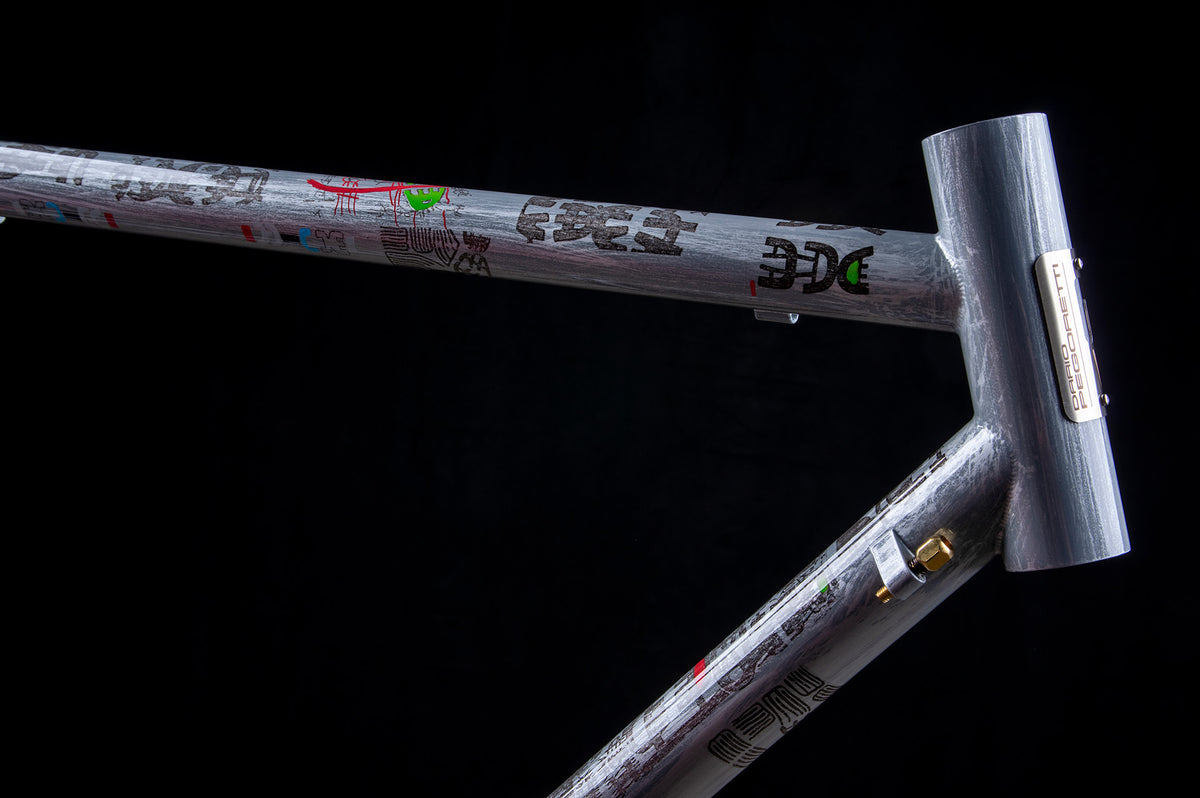
How To Measure 1” Threaded Headsets On Vintage Bikes
If you’re building a vintage bike, there are a number of parts that can be slightly complicated if you don’t have the old part to hand, and one that we are often asked about is headsets. If you buy an old steel frame set the chances are that it will take a 1” headset, there are unfortunately a few different configurations of the 1” headset though, and they aren’t all interchangeable! The below is relevant for 1” threaded headsets as that covers the majority of vintage steel bikes.
 A classic Campagnolo headset on this Masi.
A classic Campagnolo headset on this Masi.
Firstly, measure the fork right at the bottom of the steerer tube, this will give you the crown race diameter – it is important to get an exact size for this so we would recommend a set of vernier calipers, which are really handy for many bike restoration jobs so worth investing in. If the crown race measures 26.4 mm (or thereabouts) then the crown race is what we call ‘ISO’, if the crown race is 27.0 mm (or thereabouts) then the crown race is ‘JIS’. French and Campagnolo headsets often have a 26.5 mm or 27.0 mm crown race too, so use the rest of the dimensions to narrow it down. Sometimes you will find that it sits somewhere in-between, invariably old bikes get knocked about a bit!
 A pair of vernier calipers will help you measure the crown race accurately.
A pair of vernier calipers will help you measure the crown race accurately.
Next measure the inside of the frame head tube – if the measurement is 30.0 mm (+/- .05 mm) then it is a JIS headset, or possibly a Raleigh proprietary headset (if the frame is clearly a Raleigh this will help in that regard!). If the frame is slightly wider at 30.2 mm (+/- .05 mm) then it is what we call an ISO headset, which includes ‘ISO standard’ (also called BSC or ‘British’/’English’ thread), Campagnolo and Italian headsets, or French.
 The internal diameter of the frame's head tube will give you the cup size.
The internal diameter of the frame's head tube will give you the cup size.
Measure the inside and outside diameter of the fork at the top where the stem goes in – if the outer dimension is 25.0 mm and the internal dimension is 22.0 mm the headset you require is French. If it is 25.4 mm on the outside and 22.2 mm on the inside then it is ISO/JIS.

Accurately measure the external and internal diameter of the fork's steering column.
The threading of the fork will really help you nail it along with the other dimensions above, and if you have a threaded top cap you know the dimensions of that will be a great help – if you don’t have anything to hand most local bike shops should have something squirrelled away in a drawer you can borrow in exchange for some biscuits. All of the ISO standard headsets and JIS headsets will thread onto the same fork and are interchangeable from that viewpoint, a French threaded top cap will not as it has both a different thread and slightly narrower steerer column. Further if there is a flat filed onto the back of the thread it is most likely to be French too.
 Spare headset lock nuts in the workshop, useful for identifying a fork thread quickly.
Spare headset lock nuts in the workshop, useful for identifying a fork thread quickly.
Putting all of this together should help you identify which size headset you need:
| Crown Race | Headtube ID | Steerer OD | Steerer ID | |
| JIS | 27.0 mm | 30.0 mm | 25.4 mm | 22.2 mm |
| French | 26.5 / 27.0 mm | 30.2 mm | 25.0 mm | 22.0 mm |
| ISO* | 26.4 mm | 30.2 mm | 25.4 mm | 22.2 mm |
| Italian | 26.5 / 27.0 mm | 30.2 mm | 25.4 mm | 22.2 mm |
*ISO = Standard/British/BSC/English/Campagnolo and some Italian headsets (mostly interchangeable!)
A word on stack height: the overall height of the headset is referred to as ‘stack height’, and basically relates to the amount of space available on the fork steerer for the headset to be safely installed on a bike (if you get a headset with too much stack you won’t be able to tighten it properly). To easily check the minimum stack height required, first measure the length of the frame’s head tube, then take this measurement away from the length of the fork steerer column. Some headsets take up a lot of height, and fork steerers were often cut down to fit a headset installed in the past, so if your frame once ran a low stack (30 mm ish) headset that’s what you will need to use now.
Typically there are some more, very obscure options, but the above covers about 95% of good quality vintage bikes.
 A side to side comparison showing the difference between stack heights: Tange Passage low stack on the left, Shimano 600 on the right.
A side to side comparison showing the difference between stack heights: Tange Passage low stack on the left, Shimano 600 on the right.
If you enjoyed this article please don't forget to share it around 😊
Leave a comment
Comments will be approved before showing up.
Also in The Journal

Eddy Merckx - The Cannibal

Art & Bicycles – Dario Pegoretti - An Italian Master


Roly Seaton
Author